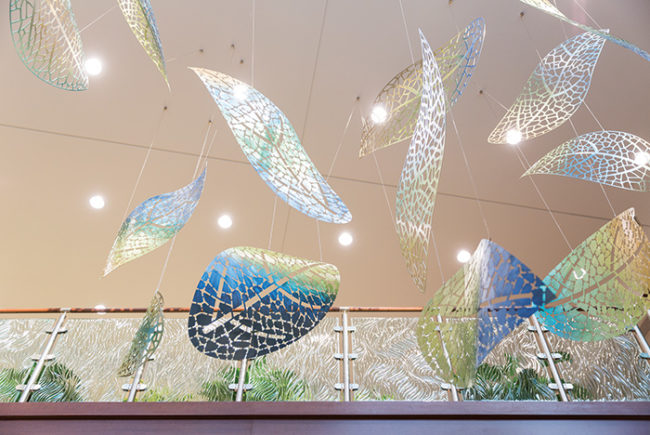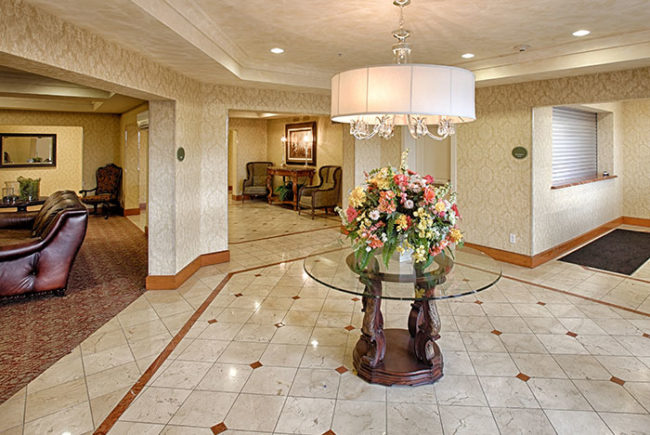Oftentimes when designing patient rooms in an acute care setting, designers do not consider that a high percentage of admissions are senior citizens. That being said, there are certain issues that must be considered; some focus on sensory perceptions, including visual, lighting, audio and tactile, as well as communication. All hospitals have a common goal in mind — to keep patients safe — and design is an important factor in achieving this goal. Two projects into which CallisonRTKL’s health care interior design team implemented these important factors are the King Abdullah Medical City in Mecca, Saudi Arabia, and the Northwestern Medicine Central DuPage Hospital in Winfield, Ill.
Visual: Colors to avoid and include
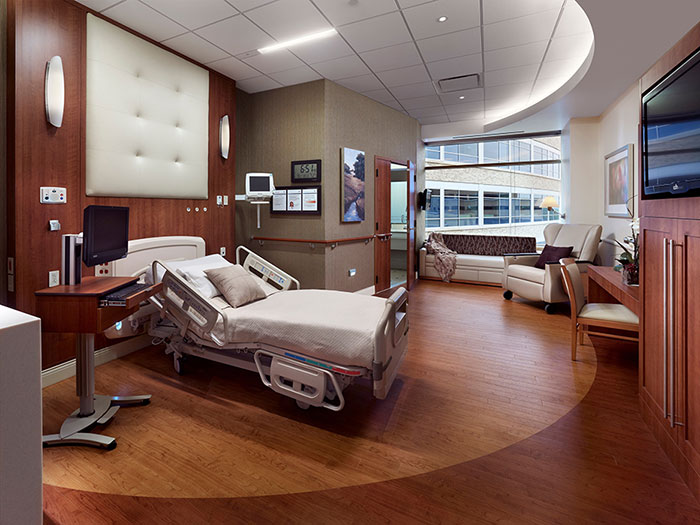
Northwestern Medicine Central DuPage uses materials with contrasting dark and light colors to help senior patients better navigate through the hospital.
There are many visual factors that, if kept in mind during design, could improve a senior’s well-being and experience in a hospital. One factor is limiting the use of blues/greens, since these colors are often indistinguishable and sometimes look gray to seniors.
Depth perception can be a challenge for senior patients. Using materials with high contrasts, such as placing a light beige chair on a darker wood floor or using materials with different patterns, textures and colors, is very important; materials with the same tone can be hard for some seniors to distinguish at what point one material starts and the other stops.
At King Abdullah, the floor was made much lighter than the walls, and the chair and couch provide a much darker contrast to be able to identify against the flooring. The millwork on the walls is also much darker than the flooring to provide the same effect. The patient rooms at Central DuPage Hospital exclude the problematic blue/green colors and provide a contrast between the chair and couch against the flooring.
Lighting: Give patients control
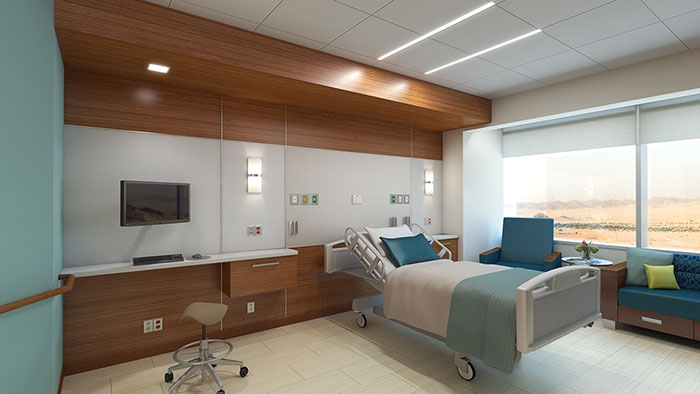
King Abdullah patient rooms includes several lighting options and controls.
For seniors, certain types of lighting can cause a negative reaction to glare and seem blinding. An indirect, softer light to reduce this glare is key. With today’s increased use of LED lighting, technology exists in patient rooms to turn lighting up or down to give patients control. This not only enables patients to see better, but it also aids in their safety and protects them from being blinded by glare.
Having multiple sources of lighting makes the environment interesting as different levels of illumination provide contrast. There are many different types of lighting at King Abdullah including natural daylight, lighting over the bed for reading, sconces for soft, ambient light, and downlight for the clinician, which is far enough from the patient to prevent glare.
Audio: Decrease noise pollution
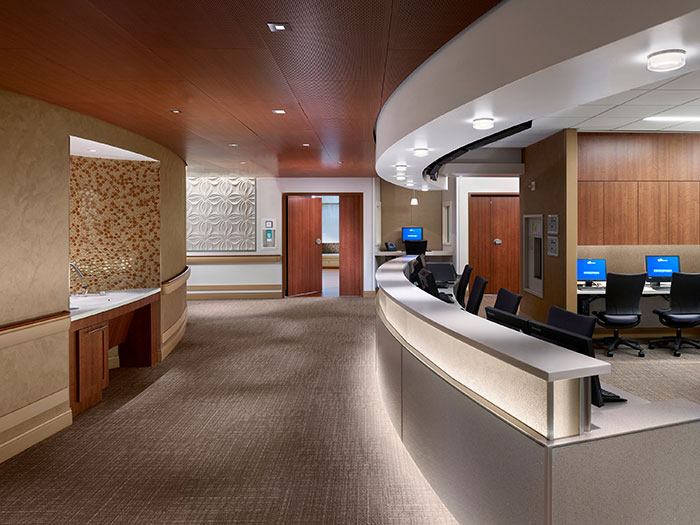
Northwestern Medicine Central DuPage has carpeted corridors to absorb sound and reduce disruptions to patients.
Managing hospital noise and creating a quieter environment for patients is critical to the healing process. A quiet patient environment is also important, since it is graded on a hospital’s HCAHPS scores. Many elderly patients can have diminished hearing, and poor acoustics can exacerbate the problem. An environment with multiple hard surfaces is problematic. Noises can bounce off these surfaces and create unwanted distractions. For seniors with hearing difficulty, it often results in their “tuning out.”
It is also important to control noise so patients can rest well. Sound-absorbing surfaces can create a better ambience and allow for less disruption. Such materials as carpet, fabric and textiles should be used in the design. Many facilities now are putting carpet in the patient corridors, creating a quieter environment for patients. At Central DuPage Hospital, carpeted corridors were implemented to absorb sounds and reduce disruption to patients.
Tactile: Mitigate the risk of falling
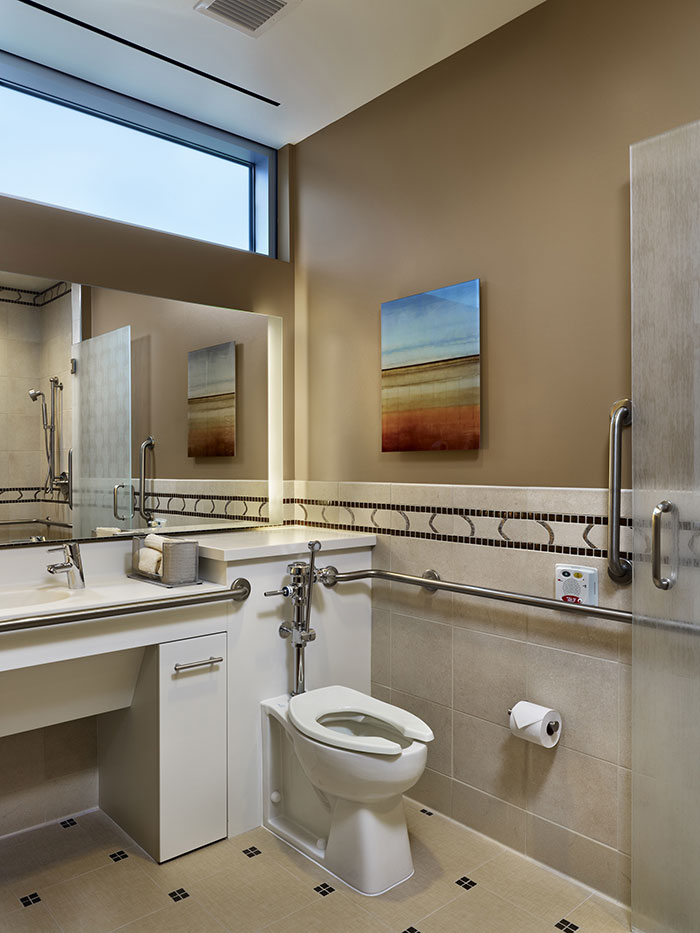
Handrails in Northwestern Medicine Central DuPage’s patient rooms run continuous from the bed to the bathroom to mitigate fall risks.
Small details can help seniors to feel more independent; they can alleviate stress, while also keeping them as safe as possible. One of the biggest problems for senior patients in hospitals is the risk of falling. Sometimes, patients who do not want to wait for help get out of bed unsteadily and end up falling. To reduce this risk, facilities implement nonslip flooring, for added safety. A continuous handrail from the bed to the bathroom also will steady them while making them feel more independent.
The King Abdullah facility installed a countertop near the patient bed to aid in standing up and a handrail that connects from the countertop to and throughout the bathroom. Handrails around the patient rooms and bathrooms in Central DuPage Hospital are were implemented. This gives the patient something to hold on to when maneuvering around the room.
Other factors in the patient room allow for a more comfortable and convenient environment for senior patients. An upright chair that is of shallow depth, making it easier for senior patients to get out of, is preferred over a lounge chair that is deep.
A programmed pillow speaker in the rooms at King Abdullah allows patients to control the motorized window shades, the room temperature, the television and light. This functionality allows for individual control of patient room features and provides a more enjoyable experience.
Communication: Overcome barriers in care
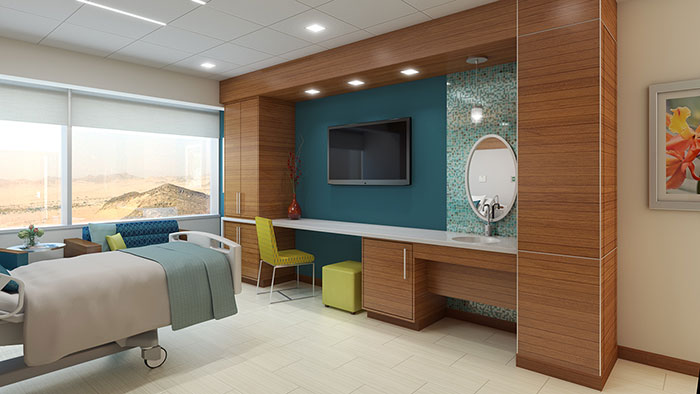
Space for family members and caregivers at King Abdullah Medical Center ensures patients have the support they need during their stay.
Informing patients of what is happening with their care or what is going to happen is extremely important. Some elderly patients do not process information well, which leads to stress and anxiety. Improving this communication is vital.
King Abdullah strived to make information accessible and easily understandable to all patients. A patient board was positioned close to the bed so that it would be easy to see the date, weather details, name of the doctor and their caregiver for the day. An attractive layout with a quick summary of important information allows senior patients to be reminded of what they might have questions about.
Accommodation for loved ones and visitors also should be factored into the facility design. Family members or friends might be with the patient to give care or support, so comfortable accommodations are necessary. Many new, private patient rooms have sleep sofas, a second TV monitor, and a desk with a chair to create a workstation within the room.
Certain issues in health care facilities can affect a high percentage of patients, including senior citizens. Interior design solutions to address these issues are vitally important to maintaining the health and safety of senior patients and enhancing their experience.



